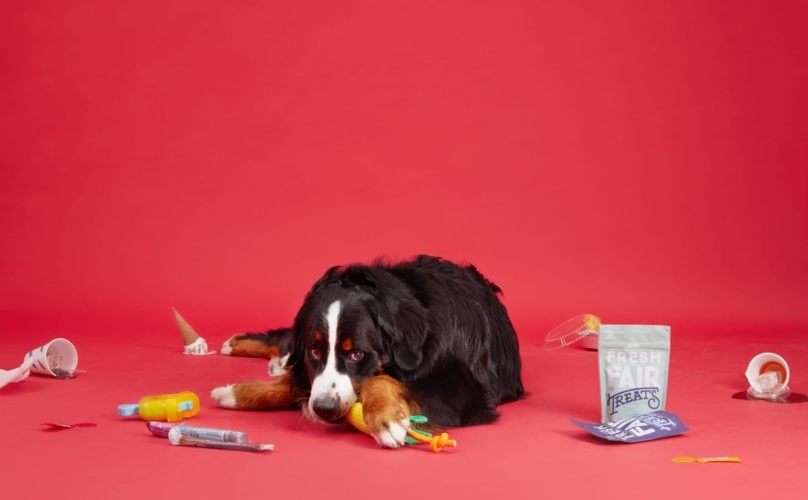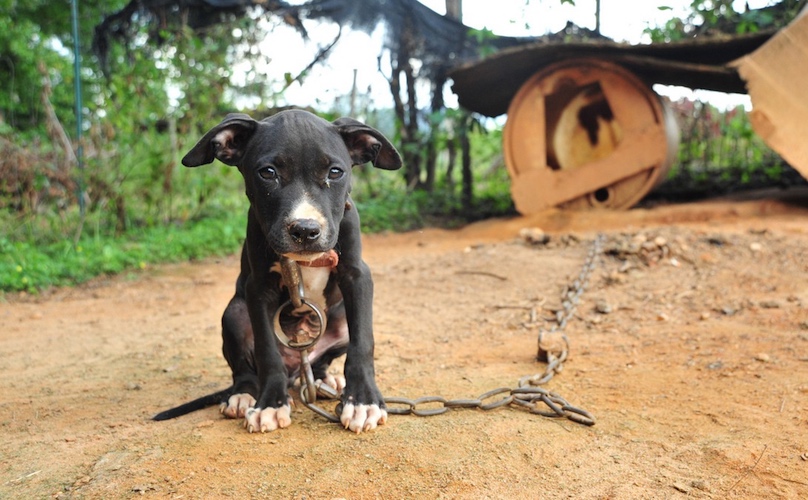In January of 2014, the ASPCA made a major shift in how they went about protecting the animals of New York City. For 137 years, the group had been responsible for enforcing the city’s animal cruelty laws, but according to President and CEO Matt Bershadker, it was becoming increasingly evident that this strategy was an old one that needed altering. Therefore, in order to effectively combat all the heinous acts committed against animals in NYC, the ASPCA joined forces with the New York Police Department, who then became the primary force in responding to alleged animal cruelty complaints.
Says Bershadker:
We asked [the NYPD] to do what they do well, which is to track down criminals and investigate alleged criminal activities, and we’re doing what we do well, which is to care for and rescue and rehome homeless animals and formerly abused animals. […] The NYPD partnership and the resulting strategies are something this organization is very proud of, and I would amplify how excited we are and how pleased we are with the partnership with the NYPD. They have been […] an incredible partner with us.
Thanks to the size, scope, and manpower of the NYPD, the new strategy was a massive success. As a result of the partnership, the number of animal abuse cases shot up over 200% from 2013 to 2014 – from 133 cases to 422 – and has since gone up another 80% from 2014 to 2015. Keep in mind, these are cases that would’ve gone unnoticed or uninvestigated under the previous strategy, due to a lack of resources. Now, these animals are saved and treated as they continue on their path toward healing and – hopefully – adoption.
The Canine Annex for Recovery & Enrichment (Or CARE for Short)
It almost goes without saying that a 280% rise in abuse cases would mean that a new ASPCA facility – one dedicated exclusively to helping abused animals – would be necessary. And so, the Gloria Gurney Canine Annex for Recovery & Enrichment was created. Built out of an old dog spa and daycare facility, CARE was completely remodeled and retrofitted to cater to the needs of these severely abused dogs.
When we visited the facility, we were shown three main areas – the Play and Training Room, The Villages, and The Kitchen.
The Play/Training Room is a big enclosed space at the center of CARE where the enrichment coordinators, behavior counselors, and K9 caregivers can take the dogs to play, to be assessed, to go through their enrichment, and so on.
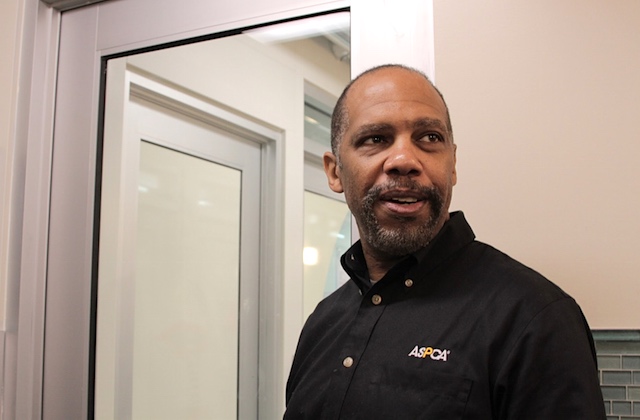

According to Arthur Hazlewood, Senior Director at the ASPCA Adoption Center:
A number of animals who have been victims of cruelty have come from environments where maybe they didn’t get out at all and they’re not accustomed to being out on the street, so this is a way to get them some exercise, get them some enrichment, without being forced into everything that’s out there on the street. It’s crazy for them. We get accustomed to the sound of the bus starting and the people walking back [from the store] with their carts. For some of these animals, it’s really pretty difficult, and this is the first phase of doing an assessment and getting them accustomed to interacting with people and seeing some of the various sights of the city.
The Villages (three altogether) are where the dogs are housed, and they can accommodate up to fifty at once.
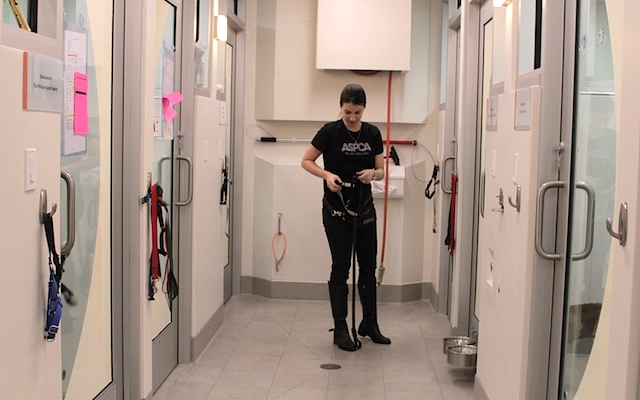

Anyone who has ever stepped foot inside a shelter or a rescue boarding facility can attest to how noisy they oftentimes are. And that makes sense! When you put a bunch of animals together that are known for howling, barking, and baying, among other boisterous activities, things can get a bit cacophonous from time to time. But that’s what’s so unique about the villages at CARE – they’re unusually quiet. Even when we entered Village #1 and greeted the dogs, we were all surprised by how much quieter it was than any previous boarding facility we’d ever visited.
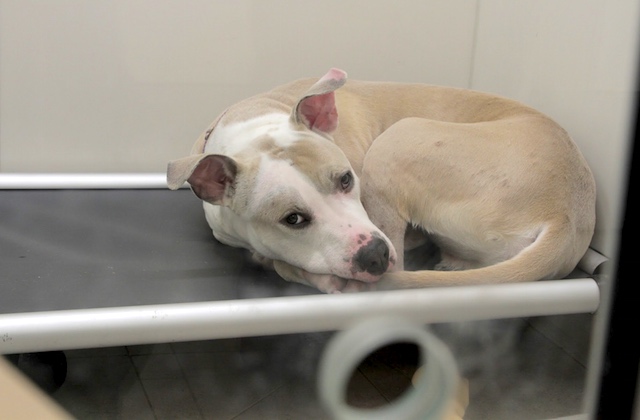

That’s because the ASPCA has gone to such great lengths to make these dogs as comfortable as possible. For example, each village has its own music control that plays (primarily) easy-listening tracks to keep the dogs calm. The colors of the walls and floors are all muted – no whites, which tend to fluoresce – to make them more palatable to the dogs. The villages all have solar tubes in the ceilings that allow natural light to shine in; this way, the dogs can adjust to a normal sunrise/sunset cycle. Each and every kennel has its own dimmer switch, in case a dog does better with less light. Each and every kennel has a nose hole where the dog can sniff, receive treats, or slobber all over your hand, if you’re into that kind of thing. (My hand got pretty slobbery.) And every door to every kennel has a half-moon decal so the dogs aren’t forced to stare at each other all day long and can hide if they so desire.
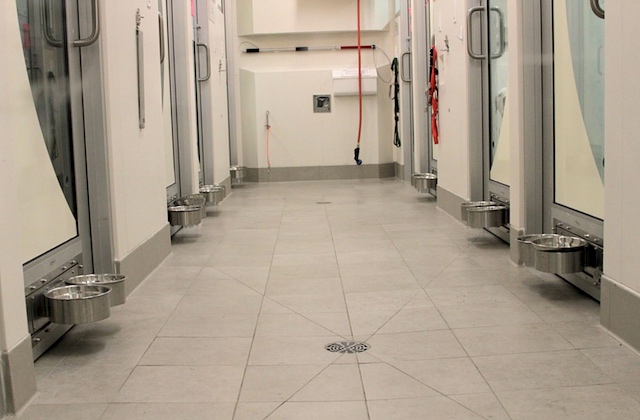

Villages #2 and #3 were made to house the dogs who might be a little bit more fearful of humans. As such, each of the kennels has been outfitted with food bowls that can be rotated to the outside and filled with food and water, then rotated back so the dogs can eat and drink without being disturbed. Villages #2 and #3 also have sliding doors between the kennels for when a dog is reactive or can’t be allowed out. An ASPCA worker can then go in, close the sliding door, and clean the kennel, all without laying hands on the animal. Although this kind of reactivity isn’t necessarily all that common, it is occasionally a necessity.
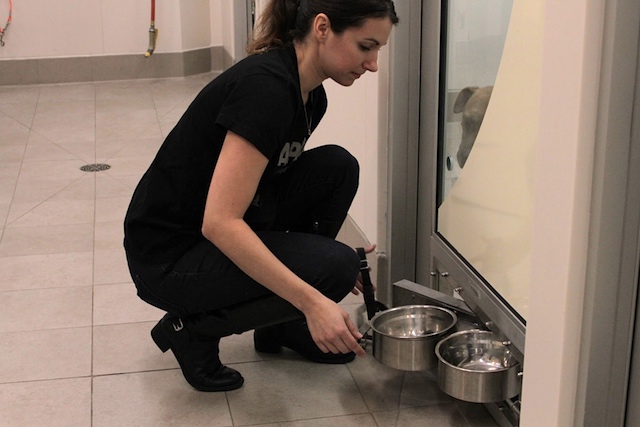

Says Arthur:
We recently had a dog come in with puppies, and was showing a lot of maternal aggression, so this was a way for her to be in there with her puppies [while we performed] maintenance and cleaning on the other side.
In The Kitchen, Enrichment Coordinator Patricia Casey gave us the rundown on the types of enrichment the dogs receive to make them physically, mentally, and emotionally more healthy. Basically, there’s a general enrichment plan that’s tailored to individual dogs and it includes food, physical activity, and socialization.
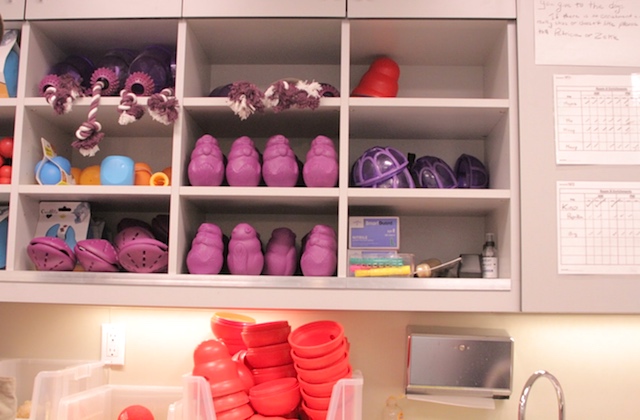

Dogs receive supplemental food enrichment (peanut butter, kibble, baby food, et cetera) three times a day in all manner of delivery devices, including Kongs, Wobblers, and Busy Buddy Squirrel Dudes. If a dog can’t, for whatever reason, receive toy enrichment, they get to eat a doggy cupcake or cookie, which consists of frozen wet foods and peanut butter and looks surprisingly delicious. All of this is separate from their regular meal plans, which are typically kibble-based and change depending on the dog’s needs (e.g., if they’re on a hypoallergenic diet, a kidney diet, a urinary diet, or what have you).
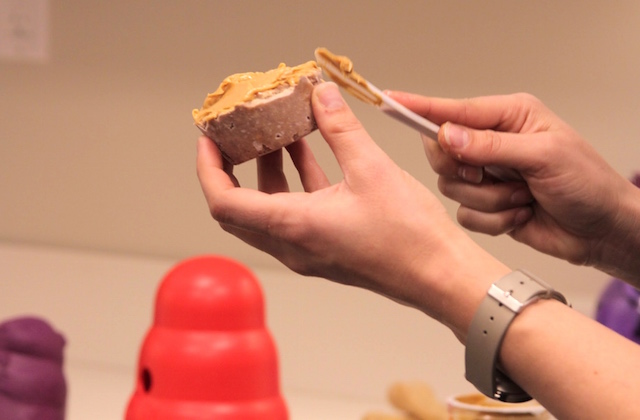

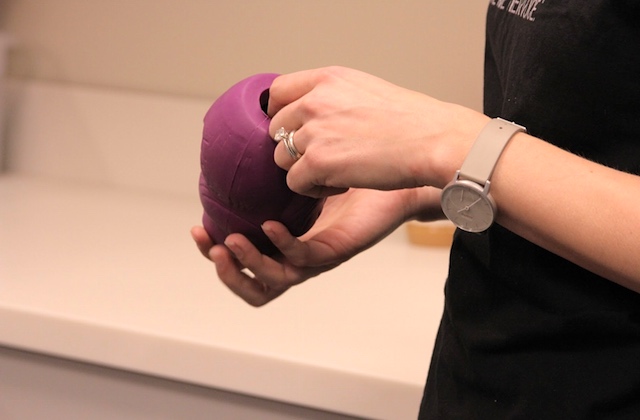

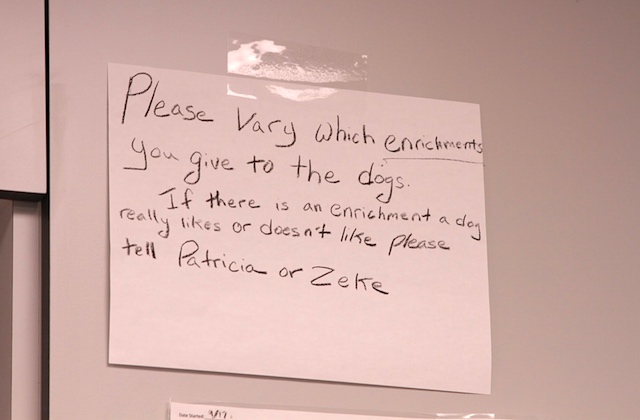

To keep the dogs busy and mentally stimulated even when they’re by themselves, they always have a Nylabone, a Galileo Bone, or an all-natural chew in their kennel. Some dogs – the ones who are really smart – even get to play with the Bust-a-Cube. Like The Wobbler, you put the food inside it and the dogs have to knock it around to get it out. Unlike The Wobbler, there’s no one way to get food out and it’s different every time.
Says Patricia Casey:
Everything we do, the food, the toys, the socialization, the play, it’s focused on having the dogs make the right associations and engaging them physically, emotionally, and mentally, so we can keep them happy here and help to get them where they need to be so they can get through the adoption center and to their home and their new friends.
The Dogs of CARE
It’s no secret that Pit Bulls make up the grand majority of shelter dogs across the country and especially in metropolitan cities like New York. Not all of the dogs we saw at CARE were Pit Bulls or Pit mixes, but I think it’s fair to say that the grand majority of them were. And indeed, CEO Matt Bershadker indicated that Pit Bull-type dogs are what the ASPCA typically sees at the center.
We do see a lot of Pit Bull type dogs come in through the NYPD partnership. They are one of the most popular breed types being adopted from shelters nationwide but also likely among the most abused. Many of these dogs just want to bond with and please their owners and to have that desire used against them is the ultimate betrayal.
Many of the dogs at CARE could not be photographed because their cases just weren’t far enough along in the legal system yet, but we were allowed to take pictures of three – a male dog named Alvin, a female dog named Blondie, and a female dog named Holland.
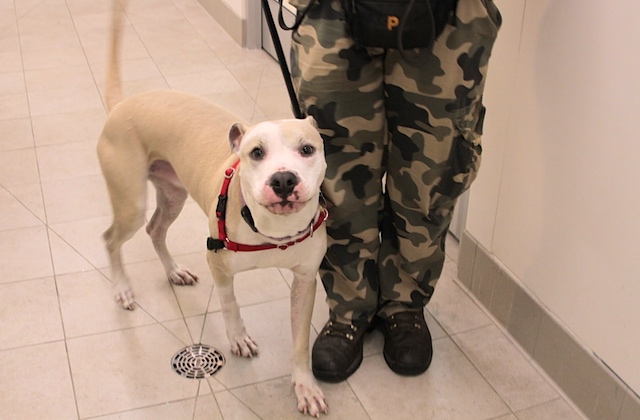

Alvin is a 3-year-old Pit Bull mix who, in July of 2015, was rescued along with three other dogs and a cat from filthy living conditions in The Bronx. Apparently, when he was found, he was extremely emaciated, barely able to stand on his own, and had physical signs of malnutrition. You’d never know it from looking at him now, as he’s filled out quite a bit and looks like a strong, healthy Pit Bull. His case is still active with the Bronx District Attorney’s Office.
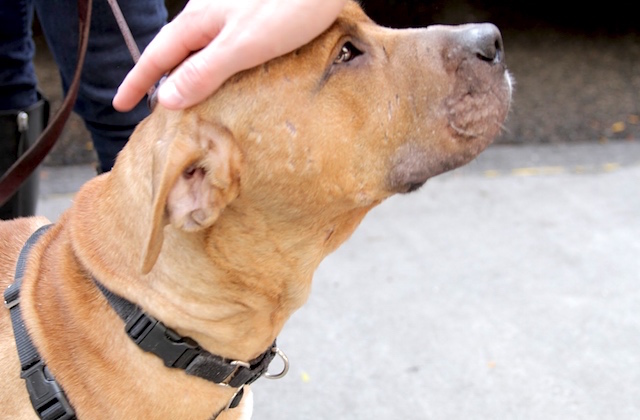

Blondie is a 5-year-old Pit Bull mix who was found abandoned in Brooklyn. Since her case is ongoing, no additional details were given to us, though there were clear physical signs of trauma on her body, including scars on her face. Blondie was ridiculously tender and sweet and seemingly just wanted to curl up next to those around her. She also has a case of happy tail syndrome, which basically means she likes people so much that her tail gets hurt when she wags it too hard against things. As a result, she’s been staying in one of the double kennels of Village #2 to give her more room to wag. And though she was initially wary of dogs, being paired with Alvin on walks and what not has made her more confident.
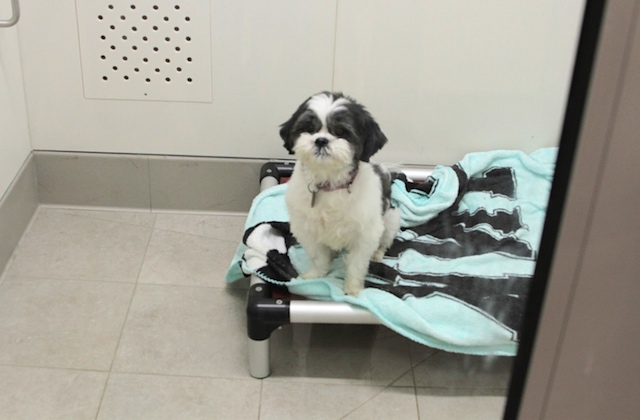

Holland is a 5-year-old Shih Tzu who was abandoned in a Bronx house for about a month before being brought to the ASPCA in late July. She was sort of the odd dog out at the Center – a small, adorable munchkin in a boarding facility surrounded by big Bully breeds.
Behavior Counseling
The number one goal here, of course, is to get these dogs adopted. But since many of them have been treated very poorly pre-CARE, it’s not unusual for them to need a little help in adjusting to the outside world so that adoption can become a reality. That’s where Animal Behavior Counselor Jonathan Aguero comes in. It’s his job to assess these animals and help train and prepare them for the potentially scary streets of New York City.
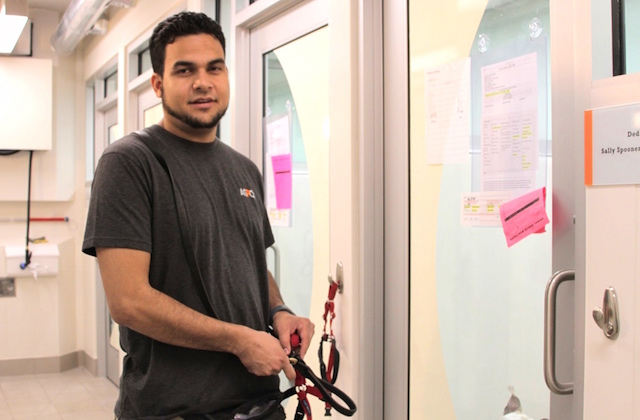

According to Matt Bershadker:
[We try] to introduce [dogs] to everyday situations so they can become accustomed to those situations, so they can learn which of those situations is actually going to be pleasurable for them. So we’re going to expose them to other dogs. We have a fake toddler test – the immediate reaction is the genuine reaction, they very quickly realize it’s a doll and not a real person, but the immediate reaction has shown to be genuine. We’ll introduce them to skateboards and crazy-looking people, because New York is filled with [those things]. Anything that they’re going to encounter. Something like stairs might be something that a dog needs to navigate if they’re adopted out. Some animals don’t even want to walk through doorways. So we’ll just try to get them used to any everyday situation and slowly build their confidence. The adverse behavior that’s preventing these animals from finding homes is oftentimes rooted in fear and under-socialization.
When we visited the center, Jonathan Aguero put on a little training demonstration for us in the Play/Training Room with Alvin as his pupil. While Patricia held Alvin on a leash, Jonathan entered the room in a costume – he wore a big yellow raincoat and a straw hat – before hobbling around the room with a wooden cane in hand.
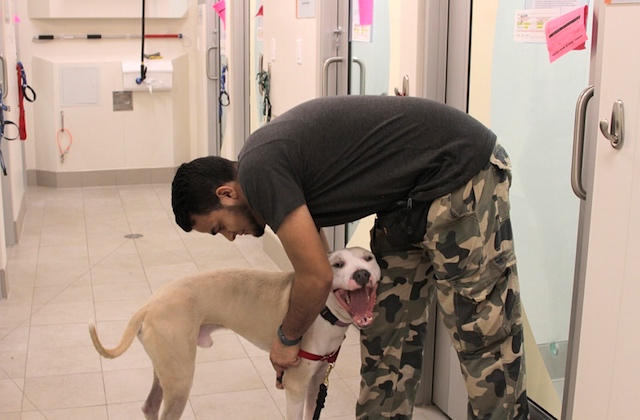

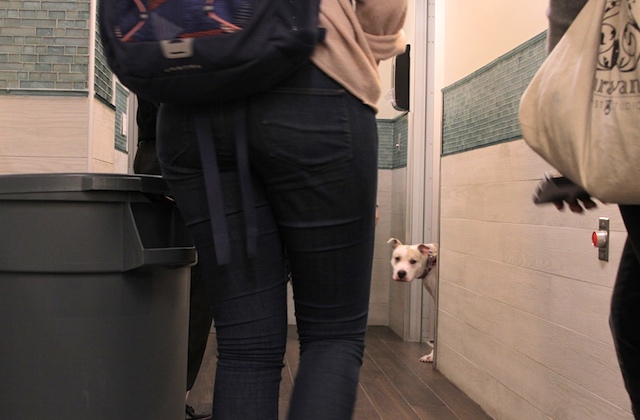

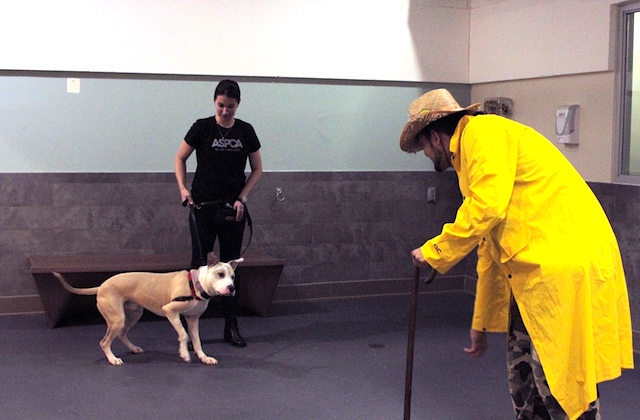

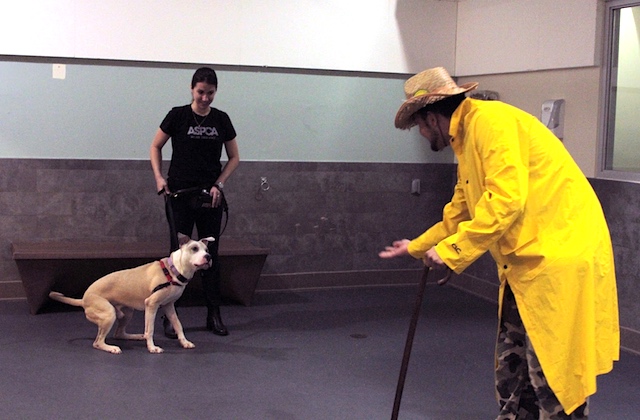

Says Arthur Hazlewood:
So what’s going on here is, we’ve noticed that Alvin has some issues with novel people, and as I mentioned before, some of these dogs have come from situations where they haven’t had much exposure to the street. Some of the things we’ll do is we’ll dress up in a novel outfit, just to get them accustomed to, again, novel people – things that are normal to us, umbrellas, hats, raincoats, wheelchairs, shopping carts, but may be a little overwhelming for them.
After hobbling around for a while, Jonathan tossed a handful of treats in Alvin’s direction. The idea behind this kind of training is to make interactions with strangers a positive experience for the dogs rather than a negative one full of fear and confusion.


And it really seems to be working! At this point, when it comes to seeing new people and things, Alvin’s basically a pro. He doesn’t bark at strange people anymore. In fact, he only really barks at his trainer to give him more treats. This is, according to Senior Manager of Media & Communications Natasha Whitling, a marked improvement from just a few short weeks ago.
Soon, Alvin will be transferred over to the adoption center where some lucky person will have the opportunity to give him a forever home. (I can attest to the fact that he’s a kisser, if that’s your jam.)
The Horrors of Animal Abuse
578 cases of animal abuse in a single year (and climbing) means that the ASPCA has seen a great number of horrible things, from severe neglect to truly unconscionable acts of cruelty. And as difficult as it can to read about such ghoulish acts, I think it’s nevertheless imperative to confront them, to be aware of what men and women are really capable of, and to know that these monstrous things aren’t just happening in some third-world country, but rather in our own backyard. After all, these dogs had to suffer through hell on Earth. The least we can do is know their stories.
Here’s what Matt Bershadker had to say about it:
So we’ve seen everything from a cat being hung out by its hind legs from the fire escape because a boyfriend didn’t want to change the litter box. We’ve seen dogs beaten with shovels and buried in the snow and left for dead. We’ve seen dogs starved within a few hours of their life, stuffed in suitcases, and thrown away in the trash. We’ve seen animals shot. We’ve seen animals so badly starved that they are feeding on dead animals that are also in the same residence. There’s something called traction alopecia which is when an animal’s hair becomes so matted that even the slightest movement rips the hair from the animal’s skin. So we’ll see a lot of that in some of the smaller breeds. The Shi Zhus, the Schnauzers, or the mixes of those types. Grooming becomes incredibly important. […] It’s pretty remarkable the unspeakable acts of cruelty that people are capable of.
Unfortunately, between 4-6% of dogs are basically too traumatized from these “unspeakable acts” to be adopted out – they might, for example, exhibit fear aggression to a degree that isn’t safe – and are thus euthanized. However, it’s important to note that as tragic as these deaths are, they’re actually incredibly low in number, something Bershadker attributes to the dogs themselves.
What [the success rate] really speaks to is the incredible resilience – and we’re talking about dogs specifically in this instance – the incredible resilience of dogs to have suffered so much at the hands of humans but still have the capacity to forgive and love. It’s pretty – that is pretty inspiring as well because I often think if I or my friends or my family would’ve suffered the same type of abuse, how quick would we be to forgive and move on? Probably not nearly as quick.
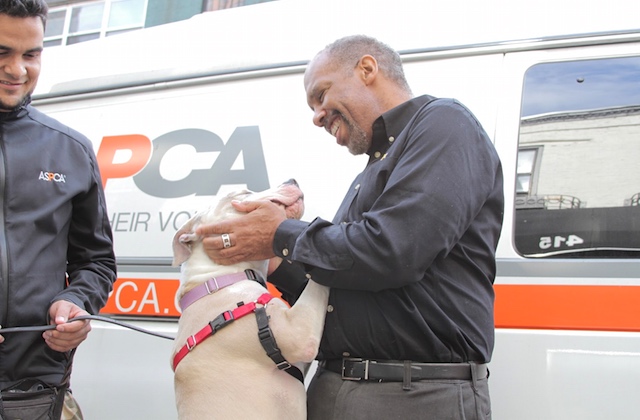

Bershadker went on to describe what it’s been like for these dogs – some of whom have lived lives free of positive human contact prior to CARE – to learn how be a dog and experience love and affection from humans.
It’s amazing and it can be – depending on the dog, every dog is an individual and every dog is going to respond to treatment differently. But for a lot of them it’s a slow, steady progress of learning to trust and to test their boundaries, and it’s pretty remarkable and uplifting to see them seek affection for the first time and to see them chase a ball for the first time. Some of the dogs are so under-socialized and fearful that we’ll pair them with another dog that’s more confident and they’ll watch that dog interact with a human and seem to enjoy it and then they’ll try it themselves. So to me it’s very exciting to watch other dogs be part of the animal’s rehabilitation and healing.
The Future of CARE
What the ASPCA is doing at CARE (with the help of the NYPD) is nothing short of incredible. Once hopeless dogs – like Alvin or Blondie or Holland – now have a chance at a wonderful life in a wonderful new home. It’s the sort of happy ending that almost makes you forget about how badly it all began.
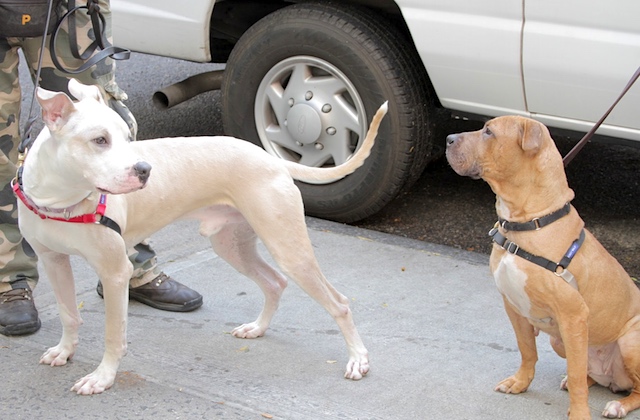

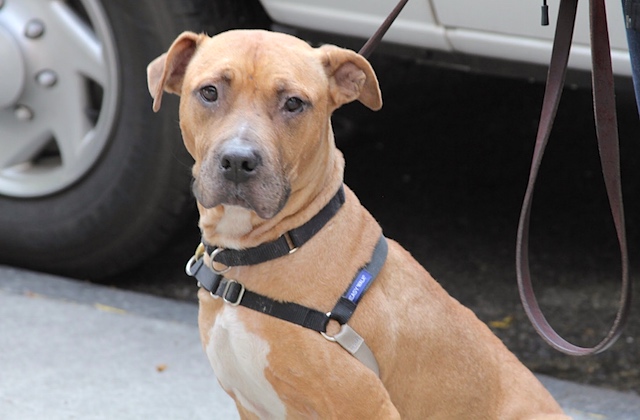

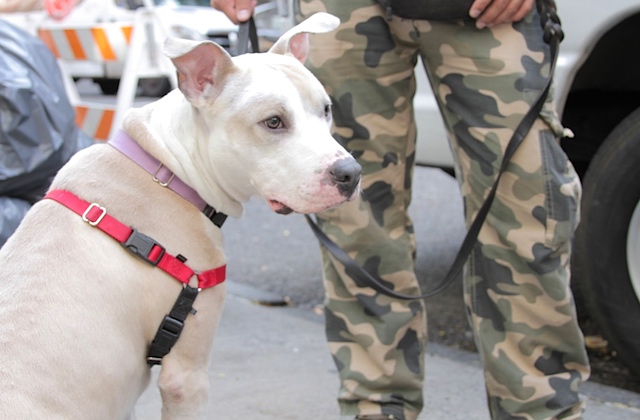

But for all the good CARE does, Matt Bershadker would prefer we live in a world that didn’t need it:
I hope one day that we close the center because it’s not necessary. But [aside from that], the hope would be that we continue to learn what it takes to recover these animals so we can recover them more quickly. The hope would be to find more loving homes for animals. The hope would be that through the center’s work and stories like the one you’re working on, we can continue to elevate the status of animals in the eyes of the law so people in our society and in our culture afford them the respect and love that they deserve. And everything the ASPCA does is designed around sharing those learning with other organizations around the country who are dealing with the same issues. We can’t be everywhere and we can’t treat every victim of abuse, but we can share what we know with everyone who’s willing to listen.
To ASPCA workers like Jonathan Aguero, Arthur Hazlewood, and Patricia Casey – people who work every day to give these dogs the happy endings they deserve – thanks for everything that you do, and keep fighting the good fight for as long as it needs fighting.
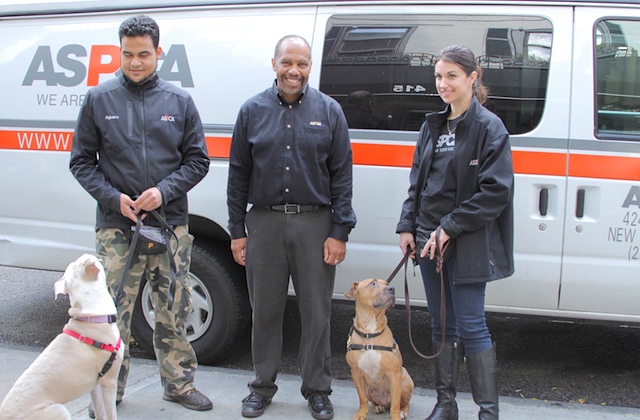

Photos by BarkPost Managing Editor Lisa Bernier




